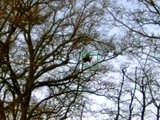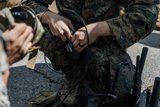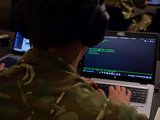Fortress Technologies enables the warfighter; delivers better training, improved flexibility, and decreased costs during military exercises
Fortress Technologies, the leader in secure tactical wireless communications, today announced that its ES520 Secure Wireless Bridges have been deployed as the backbone for a new innovative communications network - a Wireless Reach-Back (WRB) project for the Naval Surface Warfare Center (NSWC), Corona Division's East Coast operations.
WRB provides extended outdoor secure wireless capabilities for fixed and mobile users in military training and bombing exercises on ranges at Naval Air Station Altoona, FL (NAS Altoona), enabling them to share critical information in a dynamic environment.
"It is essential for the military to properly train its warfighters in real-life battlefield scenarios prior to deployment," said Kevin Kohl, NSWC. "In order to conduct this training more efficiently, we needed to extend our communications capabilities to remote locations, while increasing bandwidth and complying with the stringent security mandates of the U.S. Navy. We also needed to do this without the expense of moving fixed infrastructures, trenching hard wires, or leveraging microwave technologies. WRB was the best approach and is clearly a step forward in the ability to train our soldiers for battle."
WRB consists of semi-permanent and deployable wireless mesh points strategically placed from the Marine Corps Air Station Cherry Point, NC (MCAS Cherry Point) to NAS Altoona. This allows for quick and easy reconfiguration of the range to support multiple and ever-changing training scenarios.
WRB also enables the sharing of critical voice, video, and data information over Internet Protocol (IP) during mission-critical exercises at NAS Altoona. This includes a highly integrated network that seamlessly delivers voice traffic to coordinate range safety and unit movement, video allowing the warfighter's reactions to be monitored and recorded, and control data to activate range equipment - all managed remotely from MCAS Cherry Point.
"We selected the Fortress solution because it deploys easily and rapidly, has the requisite certifications and accreditations, and creates an improved warfighter training environment," said Zac Grayner, RF Engineer, Northrop Grumman and East Coast WRB project manager. "The ES520 provides needed flexibility for the NSWC's changing requirements and can be deployed in harsh outdoor environments. WRB not only improves the efficiency of the training, but the increased communications capabilities make it safer."
Source: Fortress Technologies
More from Digital Battlespace
-
![EID to unveil new vehicle communication system at DSEI]()
EID to unveil new vehicle communication system at DSEI
The Portuguese company’s naval communications system is in service across more than a dozen countries. It has turned to its home nation for support in developing a new vehicle based C2 system.
-
![Chess Dynamics successfully demonstrates Vision4ce AI-driven tracker]()
Chess Dynamics successfully demonstrates Vision4ce AI-driven tracker
The Vision4ce Deep Embedded Feature Tracking (DEFT) technology software is designed to process video and images by blending traditional computer vision with artificial intelligence (AI) algorithms to present actionable information from complex environments.
-
![Wave Relay devices cleared for security use on commercial systems in industry trend]()
Wave Relay devices cleared for security use on commercial systems in industry trend
Persistent Systems has been cleared by National Security Agency (NSA) to transmit sensitive data on commercial networks. The devices are added to the NSA’s Commercial Solutions for Classified (CSfC) component list which also includes other companies’ products providing the same security.
-
![UK teases cyber spending boost in Strategic Defence Review ahead of “imminent” release]()
UK teases cyber spending boost in Strategic Defence Review ahead of “imminent” release
The release of the UK’s Strategic Defence Review (SDR) has been long promised as mid-year. It is possible it could be as early as 2 June although the UK Ministry of Defence (MoD) continues to play its cards close to its chest.
-
![Intelsat emphasises SATCOM resilience for SOF in contested domains (video)]()
Intelsat emphasises SATCOM resilience for SOF in contested domains (video)
Intelsat outlines how its multi-orbit SATCOM architecture is enhancing connectivity and resilience for special operations forces operating in degraded and contested environments.
-
![US Space Force’s next-generation missile warning system moves forward with $500 million in new contracts]()
US Space Force’s next-generation missile warning system moves forward with $500 million in new contracts
Next-Generation Overhead Persistent Infrared (Next-Gen OPIR) satellites are intended to provide early warning of missile launches from any location worldwide and new ground stations will result in expanded coverage of critical missile warning.























